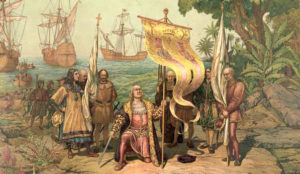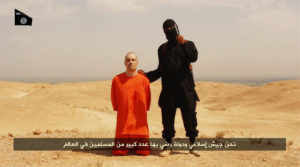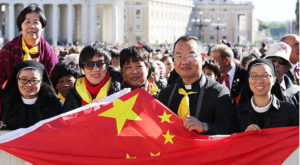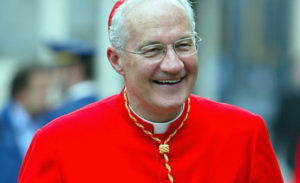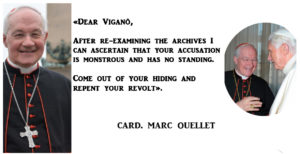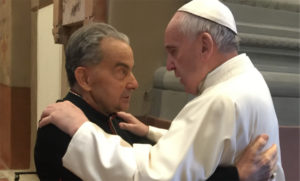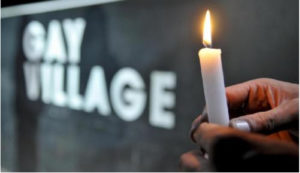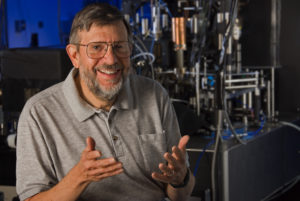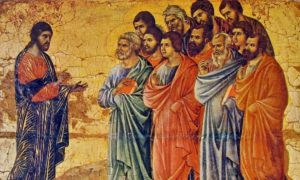 «Jesus had no intention of founding a new religion». This is the strongest statement emerged in the debate started by the review Jesus with some scholars, and it was pronounced by Mauro Pesce, full Professor of History of Christianity and the author of controversial theses expounded in his book with Corrado Augias: Inchiesta su Gesù [Inquest of Jesus].
«Jesus had no intention of founding a new religion». This is the strongest statement emerged in the debate started by the review Jesus with some scholars, and it was pronounced by Mauro Pesce, full Professor of History of Christianity and the author of controversial theses expounded in his book with Corrado Augias: Inchiesta su Gesù [Inquest of Jesus].
The attempt is to reduce Jesus to a pius Jew who only wanted to go into Judaism more in depth, by indicating Christianity only as a betrayal of his real intentions (and usually accusing Saint Paul of having been the founder of a new religion). Anthropologist Adriana Destro, for example, added: «Jesus did not want to form a separate group; he does not found a new Church. The reasons for his death, therefore, have nothing to do with theological questions, but with social and political questions». Pesce agrees and adds in the his above-mentioned book: «Jesus did not even want to change a dot, if we want to use an if we want to use a more recent term, of the Torah, that is of the religious law contained in the first five books of the Bible». But these theses are wrong.
From a certain point of view, it is true: Jesus never talks about a new religion to found. And, indeed, “Christianity” is nothing more that group of devout Jews who, meeting Jesus and living with Him, became persuaded through their experience that following His teaching teaching rather than that of the Torah would lead them to salvation and to happiness in their hearts. And out of those disciples a people was born, the followers of Christ. That is to say Chritians, that is Christianity. Father Raniero Cantalamessa rightly made a technical observation: «no religion was born because someone wanted to “found it”. Did Moses maybe want to found Judaism, or did Buddha want to found Buddhism? Religions are born and become aware of themselves only afterwards, through those who collected the thought of a Teacher and made it a reason for living». Adding, however: «not even the Church, strictly speaking, considers Christianity a “new” religion. She considers herself, together with Israel, the heir of the Old Testament’s monotheistic religion, a group of worshippers of the same God “of Abraham, Isaac, and Jacob”. The New Testament is not an absolute beginning; it is the “fulfilment” (fundamental category) of the Old». Who usually affirms that Christianity betrayed the real intentions of Jesus also forgets that as short as central passage of the Gospel: «And I tell you that you are Peter, and on this rock I will build my church, and the gates of the underworld will not overcome it» (Matthew 16:18).
The second volume of the great work Un ebreo marginale [A Marginal Jew] (Queriniana 2003), written by the main living Biblist, John P. Meier, from the University of Notre Dame, points out that, certainly, Jesus did not reject completely the religious rites of the Jewish commuity. Nevertheless, «at least at the beginning of 28 AD, the Nazarene centred his religious life on a new kind of rite which lacked the approval by tradition and by the authorities of his day. This meant the introduction of a new rite which, implicitly, questioned the efficacy of the cult then practised at the Temple and in the Synagogue (pp. 145, 146). Futhermore, contrary to John the Baptist and other original characters of the Judaism of that day, Jesus introduces a radically upsetting fact: His own person as the way to salvation, «the glad tidings of the “already but not yet” of God’s kingdom, already present but somehow still coming; the actualisation of this presence in recoveries, in exorcisms, and in the communion of the table with sinners; a new and authoritative teaching on how the laws of Moses and tradition had to be interpreted and practised, and a critical position towards the Temple of Jerusalem». «It was this exuberant and shocking novelty» – comments Meier: «to be at the centre of this message, of the action of Jesus, of the attraction (or repulsion) it caused. The baptism conferred by Jesus was the symbol for his adherence as disciple to the new message that Jesus proclaimed, and for the entry of who, man or woman, entered the new reality that Jesus brought» (pp. 174, 175).
“Shocking novelty”, “new reality”. This distinguishes the figure of Jesus, hardly reconcilable with the attempts to present him as a mere “internal rebel” of the first-Century Judaism, also because, comments Meier, «Jesus distinguishes his disciples from all the other Jews» (p. 584). Of course, it would be wrong to consider him in total “discontinuity” with what preceeded him: «A complete break with the religious history immediately prior or subsequent to him is a priori unlikely» – continued the US Biblist. «Indeed, if he had been so “discontinuous”, unique, cut off from the history flow before and after him, he would have been practically incomprehensible for everyone. Undoubtedly, however original Jesus was, he must have undergone the bonds of communication, the bonds of his historical situation, to be a successful teacher and communicator» (J.P. Meier, Un ebreo marginale, Vol. 1, Queriniana 2006, p. 166). But watch out: the fact remains that «the historical Jesus threatened, disturbed, and irritated the people, the interpreters of the Law, from the priestly aristocracy of Jerusalem to the Roman prefect who eventually put him on trial and crucified him […]. A Jesus whose words and facts did not alienate all the people, especially the powerful, from him is not the historical Jesus» (J.P. Meier, Un ebreo marginale, Vol. 1, Queriniana 2006, p. 173).
If we read the above-mentioned Inchiesta su Gesù (Mondadori 2006), Mauro Pesce himself initially holds that Jesus initially addressed only the Jews and did not want anything more than the liberation of Israel. He does so taking as guide the Gospel of Matthew, «a text with strongly Jewish characteristics» (pp. 8-13). However, after few pages, while reflecting on Nativity account in Matthew, the scholar comments the intention of the Evangelist in this way: «he wants to show that the revelation concerning Jesus as king of the Jews and Messiah was entrusted to non-Jewish priests and wise men. In this way, he justifies the fact that that message, which Jesus had offered only to the Jews, may be diffused to all people after his death. At the end of the Gospel, it is so written: “Go and baptise all nations”» (p. 35). And again: «for the Evangelist Matthew, this means perhaps that also the non-Jews are destined to inherit the salvation brought by Jesus» (p. 38).
More evident is the contradiction of another scholar convinced with the “betrayal by Christianity”, Bart D. Ehrman. «When the rich man asks Jesus how to gain eternal life, he answers him: “Observe the commandments”» – writes the Professor from the North Carolina University. However, «did the first Christians really think that, to gain eternal life, they had to observe the Law? Not at all. It was an opinion rejected by the majority of the first Christians, convinced that it was necessary to believe in the death and resurrection of Jesus to obtain it. It was not the Law bring salvation, but Jesus. Then, why does Jesus state in that passage that who observes the Law will gain salvation? Because those were the words he really pronounced» (B.D. Ehrman, Did Jesus Exist?, HarperCollins Publishers 2012, p. 317). Ehrman’s mistake is disconcerting, as he does not realise that, precisely in the Gospel passage of the young rich man (Mt 19:16-22), Jesus indicates the exact opposite: the young man, indeed, replies that he has already observed the commandments (that is the Torah, the law). «What do I still lack?». And comes the upsetting novelty introduced by Jesus: «If you want to be perfect, go, sell your possessions and give to the poor, and you will have treasure in heaven. Then come, follow me» (this saying is almost certainly historical, since it is multiply attested: Mk 10:18-21//Lk 18:18-22). Therefore, obeying the Law does not make us perfect (or holy, we would say today), according to Jesus; something else is needed: come and follow me. I am the Way, the Truth, and the Life. Not the Torah and not the Law. And again: if at page 319, Ehrman points out that «according to Jesus, who wants to enter the kingdom of God has to abide by the essence of the Torah», at page 321 and 323 he writes the opposite: «Jesus reminded more than once that the kingdom of God was already present, here and now, although in a reduced form. This was an extension of his teaching on the coming kingdom. Who followed Jesus and obeyed his words was already experiencing the future life in the kingdom of God […]. He stated, moreover, that who followed him was already foretasting the coming kingdom. In his public ministry, he was already committed to bring the kingdom of God on earth».
In the latter passage, B.D. Ehrman is rightly recognising that, according to Jesus himself, the Torah did not suffice; it was, instead, His person to guarantee the access to the kingdom of God (“already but not yet”). He claimed to be the Messiah (Mk 2:23-28), posed himself above the Sabbath, deemed as illicit some behaviours the Jews thought derived from the Torah (Mk 10:2-11 // Mk 7:19), and even openly contrasted the teaching of Moses. He taught in the name of his own authority, as if he revealed God’s will. He substituted himself to the Torah; he declared himself superior to the Temple. He conceded the remission of sins, competing only to God, which scandalised the Pharisees: the reason for his condemnation was exactly his divine claim. Spanish historian and theologian José Miguel García, from the Complutense University of Madrid, observed: «adhering to Jesus meant denying the judgment of the Jewish Synedrion and questioning the Mosaic Law; for this reason, the reaction of the Jewish authorities was violent», and indeed «the first Christian community (composed of the apostles) does not share anything with Judaism: they do not attend the Temple, if not to evangelise; they know and claim they live something absolutely new» (J.M. Garcia, Il protagonista della storia, Bur 2008, pp. 339, 400).
Thus, the thesis that Jesus did not want to create a new religion is technically wrong, not only because there is no point in using a sociologic term like “religion”, on whose meaning there still is not a clear consensus even today. On the contrary Jesus wanted in fact to introduce a message, a strongly unique, inconceivable, and upsetting announcement for the Jews contemporary to him and did not criticise only some religious forms (as though he were an internal revolutionary), but went so far as to compete with the Jewish law, by highlighting its unfulfilled nature. Indeed, the Jewish disciples recognised him as the Messiah who had been always announced by the Old Testament, and this immediately produced their clear separation from the Jews who did not recognise him (in the Acts of the Apostles one can read the pronouns “we” and “you” as a confirmation).
Eric Noffke, President of the Italian Biblical Society: «from the time of the Nazarene to the Apostles and their disciples, the new faith in Jesus gradually built itself as a completely new religion compared to Judaism». Jesus himself «had radicalised various aspects of the Jewish faith, above-all the waiting for the kingdom of God, preached as a reality present and acting in him […]. Jesus was a teacher, but he was also recognised as the awaited Messiah, although his preaching and his death on the cross had to be often explained against the average Jewish messianic tradition. Paul, therefore, far from betraying Jesus the prophet of the Kingdom, was a faithful disciple of his’ and a tireless preacher of what God had worked through him» (E. Noffke, Protestantesimo n.67, Claudiana Editrice 2012, pp. 125-141).
The Editorial Staff
 We come back, albeit briefly, on the recent study of the Shroud of Turin, concerning the pathway followed by the blood. The authors, Luigi Garlaschelli and Matteo Borrini, poured some blood on a mannequin and on the body of Garlashcelli himself, thereby comparing the blood’s pathways observable on the famous linen cloth and concluding their incompatibility. But the mistake is macroscopic, as we have written.
We come back, albeit briefly, on the recent study of the Shroud of Turin, concerning the pathway followed by the blood. The authors, Luigi Garlaschelli and Matteo Borrini, poured some blood on a mannequin and on the body of Garlashcelli himself, thereby comparing the blood’s pathways observable on the famous linen cloth and concluding their incompatibility. But the mistake is macroscopic, as we have written.
 13 November, 2018
13 November, 2018






